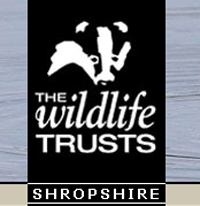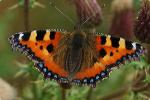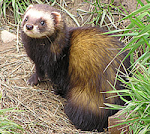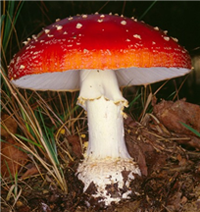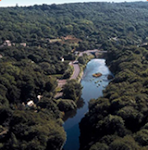Wednesday 12th November 2025, Blackbridge Quarry
Wednesday 19th November 2025, Block Wood (Kerry Ridgeway)
This time the precipitation was white and crystalline ie snow. Not over most of Shropshire, where the weather was frequently sunny and reasonably pleasant. But at 400m+ on the ridgeway, conditions were rather different, as reported by our local correspondent:“We have 5+cm on the ground near the house. Away from the shelter of the house, the snow is 10cm or so. Photo of the view down the valley - the wood and fields in the distance are above Clun.”
 |
| photograph: John Lyden |
Wednesday 26th November 2025, Bucknell Wood
With the forecast threatening nothing worse than mildly unpleasant weather, this trip went ahead as planned - hurrah! In the event the weather was almost benign, in a Novemberish sort of way. In fact the journey to site was conducted in rather glorious sunshine, affording spectacular views of Brown Clee Hill from the Much Wenlock to Craven Arms road:The woodland at Bucknell is managed by Forestry England and is a mixture of deciduous and coniferous trees (oak, larch and Douglas Fir in particular). We set off on the southerly track, hoping that its sunnier aspect would provide more finds for us. No sooner had we started than a splendid Eyed Ladybird, Britain’s largest ladybird species, was persuaded from a cypress tree.
Before long the first patches of Polytrichum moss were sighted. The vacuum samplers got to work and soon extracted several bristletails. Britain only has a handful of species of these primitive insects, but they are nevertheless fiendishly difficult to identify.
Bristletails are not creatures that we find very often. On the other hand, Britain’s commonest species of pseudoscorpion, the Moss Neobisid, Neobisium carcinoides turns up regularly and today was no exception. These arachnids are not closely related to ‘true’ scorpions, are completely harmless and at 3mm or less in length are not at all fearsome - unless you are a springtail…
 |
| photograph: Keith Fowler |
Finally, the object of their endeavours was extracted - a Snow Flea. Not a flea at all, these insects are relatives of the scorpionflies and share their distinctive long snout. Unlike scorpionflies they are flightless and at about 5mm long, are much smaller. Adults are active in the winter, from about November to February - highly unusual for an insect. They live in moss, especially Polytrichum and its relatives, and are in no way dependent on snow! This is a male. Females are stouter and have a prominent ovipositor at the rear.
Two more Snow Fleas were found later, both of them also males. Another nice find in the moss was this Red-rumped Ladybird, Scymnus haemorrhoidalis, a 2.5mm long ‘micro ladybird’ species.
Away from the moss, the Douglas Firs yielded two more ladybirds, Larch Ladybird (on the left) and Pine Ladybird. Neither of them is particularly attached to their nominal species of conifer!
A slime-mould (Didymium sp.) was discovered on a fallen leaf.
Autumn is prime fungus season. Finds from the day included Calocera viscosa
 |
| photograph: John Lyden |
Moving into an area of more open canopy woodland and clear-fell we became aware that the disappearing sun had been replaced by a rather cutting wind. Vacuuming the mossy ground vegetation failed to turn up any any more Snow Fleas, but what seemed to be a minute particle of soil suddenly sprouted a head and legs! It was scrutinised, photographed and eventually declared to be a tiny larva of the Land Caddis, Enoicyla pusilla.
This is an extraordinary insect, Britain’s only terrestrial caddisfly. It has an equally extraordinary British distribution, being confined entirely to the Wyre Forest and the adjacent parts of Worcestershire, Shropshire and Staffordshire. This discovery represents a new location, significantly further west than any previously known site.
Once the first one had been spotted it became apparent that the trays were full of them! But they were truly minute: the cases of the ones photographed measure from between 1.54mm to 1.78mm long. Surely these must be first instar larvae (which is what would be expected at this time of year). To give an idea of scale, the below photos include one climbing over a springtail and another being ‘photobombed’ by a 4.8mm long Stenus beetle.
By now the cold wind was beginning to be felt. It also felt like the day had reached its natural peak of excitement, so we began to retrace our way to the car park, pausing only for a habitat shot of the area from which the Land Caddis had been extracted.
Photographs © the author except as noted.



















































































